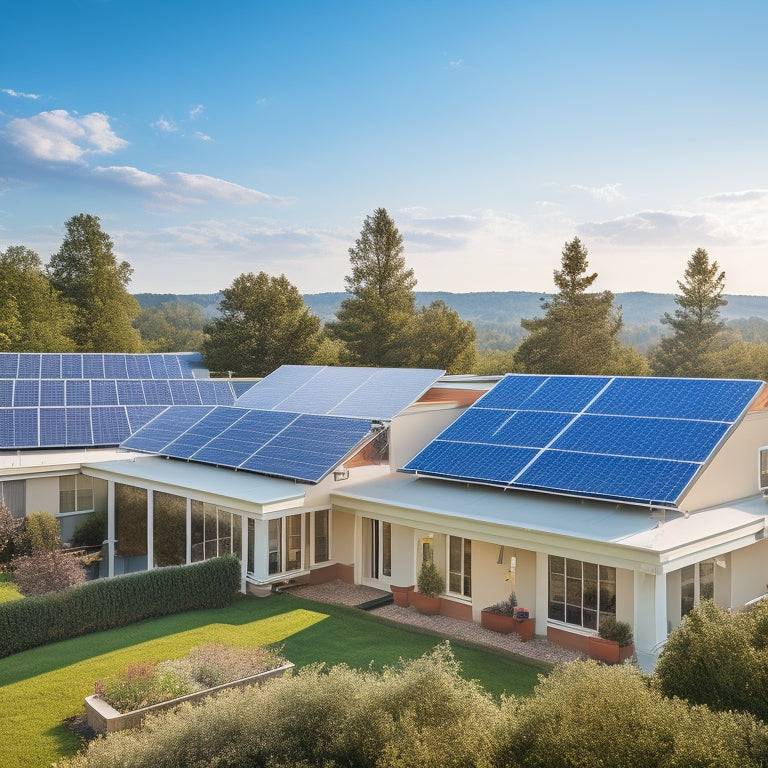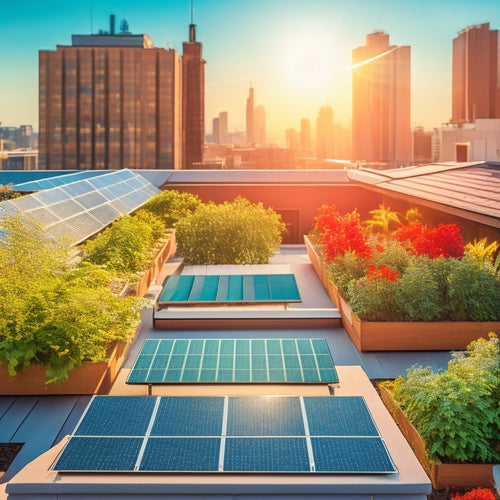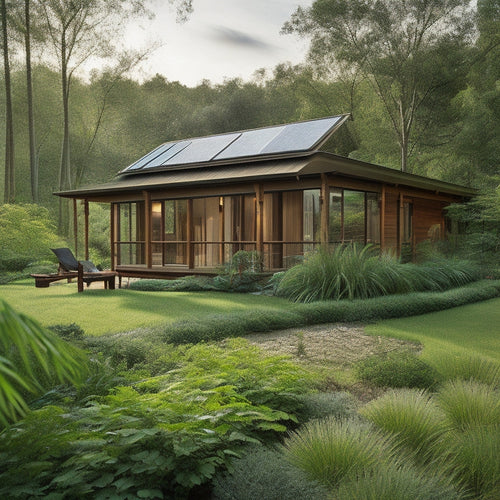
Best Photovoltaic Panels to Buy for Residential Installation
Share
You're in the market for the best photovoltaic panels to power your home, and with top brands like SunPower, Tesla, and LG offering a range of innovative and reliable options, finding the right one for your needs and budget is now more achievable than ever. When comparing brands, consider efficiency ratings, warranties, customer support, and overall system costs. Look for key features like high efficiency, durability, and safety features. Understanding efficiency ratings, energy output ratios, and panel size options will help you make an informed decision. As you investigate your options, you'll find that the perfect panel for your residential installation is just around the corner, waiting to be unveiled.
Key Takeaways
- Top brands for residential photovoltaic panels include SunPower, Tesla, LG, Canadian Solar, and JinkoSolar, offering high-quality products for diverse needs and budgets.
- Look for panel efficiency ratings between 18-22%, durability in extreme temperatures, safety features, and installation considerations like weight and mounting systems.
- Understanding efficiency ratings is crucial, with a lower temperature coefficient and high fill factor indicating better performance in varying temperatures and conditions.
- Residential panel size options range from 250 to 400 watts, with customizable lengths and compact designs available for limited roof space or unique installation needs.
- Compare warranties and support from top manufacturers, considering duration, coverage, and transferability, as well as quality customer support for optimal performance.
Top Brands for Residential Use
Several top brands dominate the residential photovoltaic panel market, offering high-quality products that cater to diverse needs and budgets. You'll find that these brands have established themselves through their commitment to innovation, reliability, and customer satisfaction.
When selecting a brand, you'll want to take into account installation considerations, such as the panel's weight, size, and mounting options, to guarantee a seamless installation process.
Brand comparisons can be helpful in determining which product best suits your needs. For instance, you may compare the efficiency ratings of different brands, such as SunPower's high-efficiency panels or Tesla's sleek, integrated solar roof tiles.
You may also take into account the warranty and customer support offered by each brand, as well as the overall cost of the system. By evaluating these factors, you can make an informed decision and choose the best brand for your residential installation.
Remember to research and compare different brands to find the one that meets your specific requirements and budget.
Key Features to Look For
Three essential aspects to ponder when selecting photovoltaic panels for residential installation are efficiency, durability, and safety features. You'll want to reflect on the panel's ability to convert sunlight into electricity, its lifespan, and its potential risks.
When evaluating efficiency, look for panels with high power output ratings and low temperature coefficients. Durability is crucial, as you'll want panels that can withstand various environmental conditions, including extreme temperatures, humidity, and weather events.
You should also think about installation considerations, such as the panel's weight, size, and mounting system. A well-designed mounting system can reduce installation time and costs.
Additionally, contemplate maintenance requirements, like cleaning and monitoring. Some panels come with built-in monitoring systems, making it easier to track performance and identify issues.
Safety features, such as fire resistance and electrical insulation, are also essential. By carefully evaluating these key features, you can guarantee a successful and safe residential installation that meets your power needs.
Understanding Efficiency Ratings
You'll want to understand the efficiency ratings of photovoltaic panels to guarantee you're getting the most energy output from your residential installation.
Two key metrics to focus on are panel efficiency and energy output ratios, which directly impact the amount of electricity your system generates.
Panel Efficiency Metrics
One essential aspect of evaluating photovoltaic panels for residential installation is understanding their efficiency metrics. When comparing different panels, you'll come across various ratings that may seem confusing. To make an informed decision, it's vital to grasp the meaning behind these metrics.
Efficiency Metrics Comparison Table
| Metric | Description | Ideal Range |
|---|---|---|
| Peak Power Efficiency | Maximum power output under ideal conditions | 18-22% |
| Average Efficiency | Average power output under real-world conditions | 15-18% |
| Temperature Coefficient | Efficiency loss per degree Celsius increase | -0.3 to -0.5%/°C |
| Fill Factor | Measures how close the panel's output is to its theoretical maximum | 0.7-0.85 |
| Module Efficiency | Overall efficiency of the entire panel | 15-18% |
When considering performance comparison, look for panels with high peak power efficiency, average efficiency, and fill factor. A lower temperature coefficient is also desirable. Keep in mind that these ratings will impact your installation tips, such as the number of panels required and their orientation. By understanding these efficiency metrics, you'll be able to make a more informed decision when selecting the best photovoltaic panels for your residential installation.
Energy Output Ratios
When evaluating photovoltaic panels, understanding energy output ratios is essential to making an informed decision. You need to know how much energy your panels will produce, and how efficiently they'll convert sunlight into power.
Energy output ratios, also known as efficiency ratings, measure a panel's ability to generate electricity from sunlight. Look for panels with high efficiency ratings, typically above 20%, to maximize energy production.
A higher energy output ratio means more power per hour of sunlight. For instance, a 300-watt panel with a 22% efficiency rating will produce more energy than a 300-watt panel with a 19% rating.
Performance tracking is critical to monitoring your energy output and identifying potential issues. Some panels come with built-in monitoring systems, while others require separate tracking devices.
Ascertain your chosen panel has a reliable performance tracking system to optimize energy production. By considering energy output ratios and performance tracking, you'll make an informed decision and get the most out of your residential solar installation.
Residential Panel Size Options
When selecting photovoltaic panels for your residential installation, you'll have various size options to contemplate.
Standard residential sizes typically range from 250 to 400 watts, but you may also find customizable panel lengths to fit your specific needs.
Additionally, compact design options are available for smaller or irregularly shaped roofs, allowing you to maximize energy production in limited spaces.
Standard Residential Sizes
Installed on rooftops worldwide, photovoltaic panels come in various standard sizes to cater to diverse residential needs. As you contemplate installing solar panels on your rooftop, understanding the standard dimensions available is essential.
Typically, residential photovoltaic panels range from 250 to 400 watts, with standard dimensions varying between 39 and 41 inches in width, and 65 to 67 inches in length.
When selecting a panel size, you'll need to take into account installation considerations such as available roof space, local building codes, and the desired power output. For instance, a smaller panel size may be suitable for roofs with limited space, while larger panels can provide more power for energy-hungry homes.
Additionally, you'll want to verify the chosen panel size is compatible with your inverter and mounting system. By choosing the right standard size for your residential installation, you can optimize energy production and reduce installation costs.
Customizable Panel Lengths
As you consider standard residential sizes, you may find that they don't quite fit your unique installation needs. That's where customizable panel lengths come in, offering installation flexibility that standard sizes can't match. By opting for custom lengths, you can maximize energy production on roofs with unusual dimensions or obstacles.
| Manufacturer | Custom Length Options |
|---|---|
| Panasonic | 33.5", 35.5", 37.5", 39.5", 41.5" |
| Trina | 32", 34", 36", 38", 40" |
| Hanwha Q CELLS | 30", 32", 34", 36", 38" |
| Canadian Solar | 31", 33", 35", 37", 39" |
| LONGi Solar | 30", 32", 34", 36", 38" |
When selecting a manufacturer, consider the custom length options they offer. Some manufacturers provide more flexibility than others, so it's crucial to choose one that aligns with your specific installation requirements. By doing so, you can guarantee a seamless installation process and maximize your energy production. With custom lengths, you can optimize your PV system's performance, even on complex roofs.
Compact Design Options
You're looking for a residential PV system that fits snugly on your roof, without sacrificing energy production. Compact design options are a great solution for homeowners with limited roof space or those who want to maximize their energy output.
These space-saving solutions allow for more efficient use of your roof's real estate, ensuring you generate the most power possible.
When it comes to compact design options, you'll want to take into account panels with a higher power density. This means more watts per square foot, resulting in a smaller overall system size.
Look for panels with a high wattage rating and a smaller footprint. Some manufacturers offer specialized compact panels designed specifically for residential installations, which can be a great option.
Aesthetic integration is also an important consideration. Compact design options can help minimize the visual impact of your PV system, making it blend seamlessly with your roof's design.
With a compact design, you can enjoy the benefits of solar power without compromising your home's appearance.
Budget-Friendly Panel Options
One key evaluation for homeowners looking to integrate solar power into their residences is finding budget-friendly panel options that meet their energy needs without breaking the bank.
You're likely looking for cost-effective alternatives that won't compromise on performance. Fortunately, there are several options available that can help you achieve significant installation savings.
Look for panels with lower efficiency ratings, typically in the 15-18% range. While they may not produce as much power per unit area, they're often cheaper to manufacture and install.
Additionally, explore panels with poly-crystalline silicon cells, which are generally less expensive than mono-crystalline cells. You can also opt for panels with a lower wattage output, which can be a more affordable option for smaller installations.
When evaluating budget-friendly options, be sure to assess the overall cost per watt, rather than the upfront cost of the panels themselves. This will give you a better understanding of the true cost-effectiveness of each option.
High-Efficiency Panel Options
High-efficiency photovoltaic panels are designed to maximize energy production per unit area, making them an attractive option for homeowners with limited roof space or high energy demands.
You'll benefit from these panels if you need to power energy-intensive appliances or have a small roof. High-efficiency panels boast higher power outputs per unit area, thanks to advanced high-performance materials and state-of-the-art manufacturing techniques.
These materials, such as high-purity silicon and advanced thin-film technology, enable more efficient energy conversion.
When considering high-efficiency panels, you should also think about installation techniques that can further optimize energy production.
For instance, using a high-efficiency inverter can guarantee that the DC power generated by the panels is converted to AC power with minimal losses.
Additionally, careful panel placement and orientation can maximize energy production by minimizing shading and reflections.
Durable Panel Options for Harsh Weather
Many homeowners live in regions prone to harsh weather conditions, such as heavy snowfall, strong winds, or intense sunlight, which can affect the performance and longevity of their photovoltaic panels.
When selecting durable panel options for harsh weather, you should prioritize weather resistance. Look for panels with high-quality materials, such as anodized aluminum frames, that can withstand extreme temperatures and weather conditions.
Installation considerations are also essential. Make certain that your panels are installed at an angle that allows snow to slide off easily, and that the mounting system is secure enough to resist strong winds.
Additionally, consider panels with built-in features that enhance weather resistance, such as drainage holes or hydrophobic coatings that reduce water absorption.
Leading manufacturers, such as Panasonic and Trina, offer durable panel options designed to thrive in harsh weather conditions.
These panels often come with extended warranties and have undergone rigorous testing to guarantee their performance and longevity.
Innovative Panel Technologies
As you investigate durable panel options for harsh weather, you'll find that innovative technologies can further enhance the performance and efficiency of your residential photovoltaic system.
One such technology is bifacial technology, which allows panels to absorb light from both the front and back sides, increasing energy output by up to 25%. This technology is particularly useful for installations with white or reflective surfaces, such as rooftops or parking garages.
Additionally, thin film panels offer a more flexible and lightweight option, making them ideal for residential installations with complex or curved roofing. These panels also tend to perform better in high-temperature conditions, making them suitable for warm climates.
When selecting innovative panel technologies, consider factors such as energy output, durability, and installation flexibility.
Warranty and Support Comparison
When evaluating photovoltaic panels for your residential installation, you're not just buying a product - you're investing in a long-term partnership with the manufacturer. The warranty terms and customer support offered by each manufacturer play a critical role in guaranteeing your investment yields maximum returns.
Top-tier manufacturers like SunPower and Panasonic offer extensive warranties with terms ranging from 25 to 40 years, covering both product and performance guarantees. In contrast, budget-friendly options like Trina and Hanwha Q CELLS provide more limited warranties, typically ranging from 10 to 25 years.
It's vital to carefully review the warranty terms, including the duration, coverage, and transferability, to confirm they align with your needs.
Additionally, consider the quality of customer support, including response times, documentation, and dedicated support channels. A manufacturer with strong customer support can provide beneficial assistance in resolving issues and optimizing system performance.
Frequently Asked Questions
Can I Install Photovoltaic Panels on a Metal Roof?
You can install photovoltaic panels on a metal roof, but you'll need to evaluate installation considerations like roof compatibility, ensuring the panels are securely fastened to the roof's structure to withstand wind and weather conditions.
Do Photovoltaic Panels Work During a Power Outage?
During a power outage, you won't have grid power, but you can achieve grid independence with photovoltaic panels and energy storage systems, allowing you to generate and store energy for later use, ensuring uninterrupted power supply.
Will Snow Affect the Performance of Photovoltaic Panels?
Like a blanket smothering a flame, snow accumulation can hinder your photovoltaic panels' performance, reducing panel efficiency by up to 50% if not cleared regularly; however, you can minimize the impact by installing your panels at an angle to facilitate snow shedding.
Can I Install Photovoltaic Panels Myself to Save Money?
You're considering self-installation to reap cost savings, but be aware that tackling installation challenges solo can lead to safety risks, warranty voidance, and potentially compromised system performance, ultimately offsetting any perceived savings.
Do Photovoltaic Panels Generate Noise or Heat?
As you utilize the power of the sun, you'll be relieved to know that photovoltaic panels operate silently, without generating excessive heat, ensuring peak photovoltaic efficiency and minimal panel maintenance for a seamless energy experience.
Conclusion
"Snap into solar success with savvy selections from top brands, featuring fantastic features, fantastic flexibility, and flawless functionality. From fabulous finances to fantastic futures, find the perfect panel to power your property. With precise performance, peerless protection, and pinpoint precision, propel your residential installation to new heights. Make a brilliant decision, backed by brilliant brands, and bask in the benefits of boundless renewable energy."
Related Posts
-

Solar System Installation Rebates and Tax Credits
Solar system installations offer beneficial rebates and tax credits that greatly cut your initial costs. You can bene...
-

Energy-Efficient Home Upgrades for Cost Reduction
To reduce costs with energy-efficient home upgrades, focus on essential improvements like smart thermostats, energy-e...
-

Affordable Sustainable Building Materials for Homes
You can build an eco-friendly home on a budget by choosing affordable sustainable materials. Consider using reclaimed...


